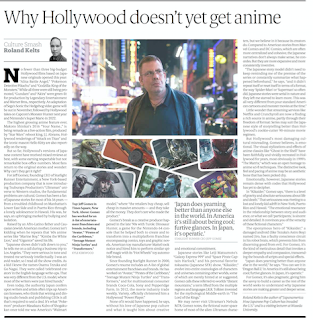Roland Kelts's Blog, page 17
October 4, 2019
Thank you, again, TOKYO
Published on October 04, 2019 04:56
September 23, 2019
Appearing in Tokyo for the BBC, Oct. 2
Published on September 23, 2019 01:39
Appearing onstage in Tokyo for the BBC, Oct. 2
Published on September 23, 2019 01:39
September 17, 2019
My New York Times story on Tokyo's renewed Hotel Okura
In a Renewed Hotel Okura, Japanese Historians Still See a Loss
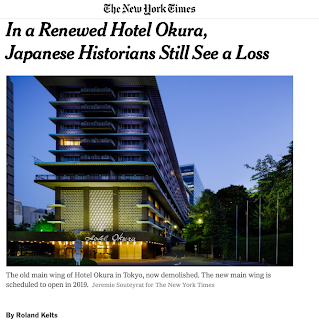 The New York Times
The New York Times
TOKYO — The outcry over the demolition of the 53-year-old Hotel Okura in Tokyo surprised no one more than some Japanese historians and architectural specialists.
Monocle, the global lifestyle magazine, had circulated a petition, savetheokura.com, to register the “outrage from admirers of its unique design.” Tomas Maier, the creative director of Bottega Veneta, an Italian luxury brand, filmed a video memorial and started a social media campaign, #MyMomentAtOkura.
The hotel’s modernist postwar lobby artfully balanced elements of traditional Japan, like lacquered plum-blossom-shaped tables and chairs, with visions of what was then futuristic, like a lighted world map displaying global time zones. It was frequented by United States presidents including President Obama, and other heads of state, celebrities, artists and designers. It played a central role in the 1960s James Bond novel “You Only Live Twice.”
Hotel Okura Co. Ltd., whose largest investors include the Taisei Corporation, a construction company, and Mitsubishi Estate, Japan’s second-largest real estate developer, plans to build a 38-story high-rise with 510 rooms, 102 more than the Okura, and add 18 stories of office space. The renovation is estimated to cost $1 billion. The company promised to “faithfully reproduce” several beloved artifacts in the lobby, including wall tapestries, paper lanterns and sliding doors, the lacquered furnishings and map of time zones.

The hotel’s main building and its signature lobby were demolished in September. The South Wing, erected in 1973, will remain operational, and the owners plan to replicate the lobby’s mezzanine, based on a Japanese painting known as “Bridge of the Dream,” and its hexagonal ceiling lights. A newly designed bar will try to recapture the stylish retro-chic of the former Orchid Bar, the Okura’s elegant, dimly lit cocktail haven loved by diplomats, expatriates and journalists. The new complex will also incorporate upgrades to meet the latest standards in earthquake-resistant construction technologies.
But those plans have done little to assuage the concerns of preservationists, many of whom contend that Tokyo is destroying its greatest postwar architectural assets to accommodate the 2020 Olympics and a recent surge in tourism. In a twist worthy of Bond, the most outspoken critics are not from Japan.
“When the reconstruction was announced, many foreigners, especially well-known designers, voiced their regret,” said Yoshio Uchida, professor of architecture at Toyo University. “The magnitude of their protest was beyond our imagination.”
Read>>
 The New York Times
The New York TimesTOKYO — The outcry over the demolition of the 53-year-old Hotel Okura in Tokyo surprised no one more than some Japanese historians and architectural specialists.
Monocle, the global lifestyle magazine, had circulated a petition, savetheokura.com, to register the “outrage from admirers of its unique design.” Tomas Maier, the creative director of Bottega Veneta, an Italian luxury brand, filmed a video memorial and started a social media campaign, #MyMomentAtOkura.
The hotel’s modernist postwar lobby artfully balanced elements of traditional Japan, like lacquered plum-blossom-shaped tables and chairs, with visions of what was then futuristic, like a lighted world map displaying global time zones. It was frequented by United States presidents including President Obama, and other heads of state, celebrities, artists and designers. It played a central role in the 1960s James Bond novel “You Only Live Twice.”
Hotel Okura Co. Ltd., whose largest investors include the Taisei Corporation, a construction company, and Mitsubishi Estate, Japan’s second-largest real estate developer, plans to build a 38-story high-rise with 510 rooms, 102 more than the Okura, and add 18 stories of office space. The renovation is estimated to cost $1 billion. The company promised to “faithfully reproduce” several beloved artifacts in the lobby, including wall tapestries, paper lanterns and sliding doors, the lacquered furnishings and map of time zones.

The hotel’s main building and its signature lobby were demolished in September. The South Wing, erected in 1973, will remain operational, and the owners plan to replicate the lobby’s mezzanine, based on a Japanese painting known as “Bridge of the Dream,” and its hexagonal ceiling lights. A newly designed bar will try to recapture the stylish retro-chic of the former Orchid Bar, the Okura’s elegant, dimly lit cocktail haven loved by diplomats, expatriates and journalists. The new complex will also incorporate upgrades to meet the latest standards in earthquake-resistant construction technologies.
But those plans have done little to assuage the concerns of preservationists, many of whom contend that Tokyo is destroying its greatest postwar architectural assets to accommodate the 2020 Olympics and a recent surge in tourism. In a twist worthy of Bond, the most outspoken critics are not from Japan.
“When the reconstruction was announced, many foreigners, especially well-known designers, voiced their regret,” said Yoshio Uchida, professor of architecture at Toyo University. “The magnitude of their protest was beyond our imagination.”
Read>>
Published on September 17, 2019 17:44
August 27, 2019
Britain & Brexit seen from Japan in The Guardian
‘Seen from Japan, Britain is no longer recognizably British’
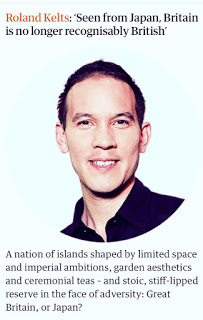 The Guardian
The Guardian
A nation of islands shaped by limited space and imperial ambitions, garden aesthetics and ceremonial teas -- and stoic, stiff-lipped reserve in the face of adversity: Great Britain, or Japan?
For many Japanese, Britain has long been something of a western mirror and model nation, a land whose geographical and cultural character were recognisable and achievements often admirable: a doppelganger off the coast of another continent and equally rich with tradition, history and parochial pride. At least, until Brexit.
Only three months after the June 2016 EU referendum, the Japanese government voiced its displeasure over Britain’s choice in unusually un-Japanese language. A 15-page memorandum issued in September 2016 by the otherwise soft-spoken ministry of foreign affairs “strongly requests” that the UK consider the facts: Japan invests a lot of money and employs a lot of workers in the UK, but Japanese businesses can’t and won’t stay in the UK if it exits the EU without the single passport and sustained immigration. In other words: with no deal.
Three years later, Japan is still pleading the case. This June, the foreign minister, Taro Kono, said that he bluntly told Boris Johnson and Jeremy Hunt: “’Please no no deal. Please no no-deal Brexit.’”
Since then, Johnson has made a no-deal Brexit seem like a no-brainer – a fait accompli for Brexit cheerleaders.
“I think most Japanese look at Britain today with disbelief, shock and horror,” Koichi Nakano, a political science professor at Tokyo’s Sophia University told me recently. “There are quite a few of us who are Anglophiles, but the Britain a lot of Japanese came to like and admire is open, cosmopolitan and increasingly integrated in Europe. The fact that Britain is inflicting on itself tremendous economic damage for what seems like a very un-British extremist ideology is astounding.”
Seen from the relatively stable shores of Japan, its western mirror image is not only cracking up – it’s no longer recognizably British.
• Roland Kelts is a Japanese-American writer and author of Japanamerica: How Japanese Pop Culture has Invaded the US. He lives in Tokyo.
 The Guardian
The GuardianA nation of islands shaped by limited space and imperial ambitions, garden aesthetics and ceremonial teas -- and stoic, stiff-lipped reserve in the face of adversity: Great Britain, or Japan?
For many Japanese, Britain has long been something of a western mirror and model nation, a land whose geographical and cultural character were recognisable and achievements often admirable: a doppelganger off the coast of another continent and equally rich with tradition, history and parochial pride. At least, until Brexit.
Only three months after the June 2016 EU referendum, the Japanese government voiced its displeasure over Britain’s choice in unusually un-Japanese language. A 15-page memorandum issued in September 2016 by the otherwise soft-spoken ministry of foreign affairs “strongly requests” that the UK consider the facts: Japan invests a lot of money and employs a lot of workers in the UK, but Japanese businesses can’t and won’t stay in the UK if it exits the EU without the single passport and sustained immigration. In other words: with no deal.
Three years later, Japan is still pleading the case. This June, the foreign minister, Taro Kono, said that he bluntly told Boris Johnson and Jeremy Hunt: “’Please no no deal. Please no no-deal Brexit.’”
Since then, Johnson has made a no-deal Brexit seem like a no-brainer – a fait accompli for Brexit cheerleaders.
“I think most Japanese look at Britain today with disbelief, shock and horror,” Koichi Nakano, a political science professor at Tokyo’s Sophia University told me recently. “There are quite a few of us who are Anglophiles, but the Britain a lot of Japanese came to like and admire is open, cosmopolitan and increasingly integrated in Europe. The fact that Britain is inflicting on itself tremendous economic damage for what seems like a very un-British extremist ideology is astounding.”
Seen from the relatively stable shores of Japan, its western mirror image is not only cracking up – it’s no longer recognizably British.
• Roland Kelts is a Japanese-American writer and author of Japanamerica: How Japanese Pop Culture has Invaded the US. He lives in Tokyo.
Published on August 27, 2019 08:12
Britain & Brexit as seen from Japan
‘Seen from Japan, Britain is no longer recognizably British’
 The Guardian
The Guardian
A nation of islands shaped by limited space and imperial ambitions, garden aesthetics and ceremonial teas -- and stoic, stiff-lipped reserve in the face of adversity: Great Britain, or Japan?
For many Japanese Britain has long been something of a western mirror and model nation, a land whose geographical and cultural character were recognisable and achievements often admirable: a doppelganger off the coast of another continent and equally rich with tradition, history and parochial pride. At least, until Brexit.
Only three months after the June 2016 EU referendum, the Japanese government voiced its displeasure over Britain’s choice in unusually un-Japanese language. A 15-page memorandum issued in September 2016 by the otherwise soft-spoken ministry of foreign affairs “strongly requests” that the UK consider the facts: Japan invests a lot of money and employs a lot of workers in the UK, but Japanese businesses can’t and won’t stay in the UK if it exits the EU without the single passport and sustained immigration. In other words: with no deal.
Three years later, Japan is still pleading the case. This June, the foreign minister, Taro Kono, said that he bluntly told Boris Johnson and Jeremy Hunt: “’Please no no deal. Please no no-deal Brexit.’”
Since then, Johnson has made a no-deal Brexit seem like a no-brainer – a fait accompli for Brexit cheerleaders.
“I think most Japanese look at Britain today with disbelief, shock and horror,” Koichi Nakano, a political science professor at Tokyo’s Sophia University told me recently. “There are quite a few of us who are Anglophiles, but the Britain a lot of Japanese came to like and admire is open, cosmopolitan and increasingly integrated in Europe. The fact that Britain is inflicting on itself tremendous economic damage for what seems like a very un-British extremist ideology is astounding.”
Seen from the relatively stable shores of Japan, its western mirror image is not only cracking up – it’s no longer recognizably British.
• Roland Kelts is a Japanese-American writer and author of Japanamerica: How Japanese Pop Culture has Invaded the US. He lives in Tokyo.
 The Guardian
The GuardianA nation of islands shaped by limited space and imperial ambitions, garden aesthetics and ceremonial teas -- and stoic, stiff-lipped reserve in the face of adversity: Great Britain, or Japan?
For many Japanese Britain has long been something of a western mirror and model nation, a land whose geographical and cultural character were recognisable and achievements often admirable: a doppelganger off the coast of another continent and equally rich with tradition, history and parochial pride. At least, until Brexit.
Only three months after the June 2016 EU referendum, the Japanese government voiced its displeasure over Britain’s choice in unusually un-Japanese language. A 15-page memorandum issued in September 2016 by the otherwise soft-spoken ministry of foreign affairs “strongly requests” that the UK consider the facts: Japan invests a lot of money and employs a lot of workers in the UK, but Japanese businesses can’t and won’t stay in the UK if it exits the EU without the single passport and sustained immigration. In other words: with no deal.
Three years later, Japan is still pleading the case. This June, the foreign minister, Taro Kono, said that he bluntly told Boris Johnson and Jeremy Hunt: “’Please no no deal. Please no no-deal Brexit.’”
Since then, Johnson has made a no-deal Brexit seem like a no-brainer – a fait accompli for Brexit cheerleaders.
“I think most Japanese look at Britain today with disbelief, shock and horror,” Koichi Nakano, a political science professor at Tokyo’s Sophia University told me recently. “There are quite a few of us who are Anglophiles, but the Britain a lot of Japanese came to like and admire is open, cosmopolitan and increasingly integrated in Europe. The fact that Britain is inflicting on itself tremendous economic damage for what seems like a very un-British extremist ideology is astounding.”
Seen from the relatively stable shores of Japan, its western mirror image is not only cracking up – it’s no longer recognizably British.
• Roland Kelts is a Japanese-American writer and author of Japanamerica: How Japanese Pop Culture has Invaded the US. He lives in Tokyo.
Published on August 27, 2019 08:12
August 14, 2019
The future of anime? LeSean Thomas' "Cannon Busters"
'Cannon Busters': Bending anime rules in all the right ways
 The Japan Times
The Japan Times
South Bronx, New York native LeSean Thomas is making anime in Tokyo partly owing to a mistake. In the early ’90s, he bought a video cassette of what he thought was “Akira” but turned out to be a behind-the-scenes “production report” chronicling the film’s creation. Instead of returning it, Thomas watched it every day. When he saw director Katsuhiro Otomo and his team working through the night at their cramped desks, he thought: That’s what I want to do.
More than 20 years later, Thomas, now 43, is about to debut as an anime showrunner with “Cannon Busters,” a 12-episode series based on his 2005 comic book of the same name and rendered by Tokyo animation studio Satelight Inc. It premieres Aug. 15 on Netflix.
“Cannon Busters” is a multinational project, created by an American, co-financed by Britain’s Manga Entertainment Ltd. and Taiwan’s Nada Holdings Inc., produced by a Japanese studio and released on a U.S.-based streaming portal.
Thomas is leading a new generation of overseas fans who not only love anime but also, increasingly, want to play a part in creating it. His journey to Tokyo took him from New York to Greensboro, North Carolina, Los Angeles and Seoul, while he honed his craft as an illustrator, television animation producer, director and storyboard artist on A-list animated shows including “The Boondocks” and “The Legend of Korra.” His original story for “Cannon Busters” combines elements of Edo Period (1603-1868) Japan, American Westerns, steampunk and Eurocentric high fantasy, with a few mecha anime robot tropes on the side.
“There are cultural motifs that we can identify and racially code,” he says, “but none of it takes place on earth.”
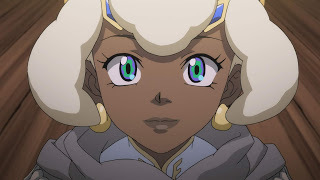 Lead character S.A.M. from "Cannon Busters" (Netflix)
Lead character S.A.M. from "Cannon Busters" (Netflix)
He first encountered Japanese animation as a teenager in the public housing projects of the Bronx, where a friend showed him a VHS tape of opening sequences and clips from a handful of late ’80s to early ’90s original video anime series, plus one full episode each of “Hyper Combat Unit Dangaioh” and “Bubblegum Crisis.” Suddenly the manga panels he’d been admiring as a reader and budding artist were moving across a screen.
“That tape was a game changer for me,” Thomas tells me over coffee in the Yoyogi neighborhood of Tokyo. “I’d never seen anyone animate anything like that. Compared to Hanna-Barbera, ‘Looney Tunes,’ and American comic books I was consuming at the time, the way anime was drawn was just a higher level of detail and technique. It was just amazing.”
In Los Angeles, Thomas worked with some of the biggest names in American animation — DreamWorks, Sony Pictures, Nickelodeon — yet remained dissatisfied with the emphasis on comedy and theatrical characters over background and environmental design.
Read>>
 The Japan Times
The Japan TimesSouth Bronx, New York native LeSean Thomas is making anime in Tokyo partly owing to a mistake. In the early ’90s, he bought a video cassette of what he thought was “Akira” but turned out to be a behind-the-scenes “production report” chronicling the film’s creation. Instead of returning it, Thomas watched it every day. When he saw director Katsuhiro Otomo and his team working through the night at their cramped desks, he thought: That’s what I want to do.
More than 20 years later, Thomas, now 43, is about to debut as an anime showrunner with “Cannon Busters,” a 12-episode series based on his 2005 comic book of the same name and rendered by Tokyo animation studio Satelight Inc. It premieres Aug. 15 on Netflix.
“Cannon Busters” is a multinational project, created by an American, co-financed by Britain’s Manga Entertainment Ltd. and Taiwan’s Nada Holdings Inc., produced by a Japanese studio and released on a U.S.-based streaming portal.
Thomas is leading a new generation of overseas fans who not only love anime but also, increasingly, want to play a part in creating it. His journey to Tokyo took him from New York to Greensboro, North Carolina, Los Angeles and Seoul, while he honed his craft as an illustrator, television animation producer, director and storyboard artist on A-list animated shows including “The Boondocks” and “The Legend of Korra.” His original story for “Cannon Busters” combines elements of Edo Period (1603-1868) Japan, American Westerns, steampunk and Eurocentric high fantasy, with a few mecha anime robot tropes on the side.
“There are cultural motifs that we can identify and racially code,” he says, “but none of it takes place on earth.”
 Lead character S.A.M. from "Cannon Busters" (Netflix)
Lead character S.A.M. from "Cannon Busters" (Netflix) He first encountered Japanese animation as a teenager in the public housing projects of the Bronx, where a friend showed him a VHS tape of opening sequences and clips from a handful of late ’80s to early ’90s original video anime series, plus one full episode each of “Hyper Combat Unit Dangaioh” and “Bubblegum Crisis.” Suddenly the manga panels he’d been admiring as a reader and budding artist were moving across a screen.
“That tape was a game changer for me,” Thomas tells me over coffee in the Yoyogi neighborhood of Tokyo. “I’d never seen anyone animate anything like that. Compared to Hanna-Barbera, ‘Looney Tunes,’ and American comic books I was consuming at the time, the way anime was drawn was just a higher level of detail and technique. It was just amazing.”
In Los Angeles, Thomas worked with some of the biggest names in American animation — DreamWorks, Sony Pictures, Nickelodeon — yet remained dissatisfied with the emphasis on comedy and theatrical characters over background and environmental design.
Read>>
Published on August 14, 2019 02:20
July 24, 2019
How Disney ripped off Tezuka: The Lion King vs Kimba The White Lion
Big Little Lions: Disney's New 'Lion King' Dodges the 'Kimba' Similarity Issue
 The Hollywood Reporter
The Hollywood Reporter
Over the years, however, many anime fans have speculated that there were, perhaps, other reasons that Tezuka Productions declined to take legal action against Disney, with some even suggesting that the company might have paid them off in secret.
However, in the 2006 book Japanamerica: How Japanese Pop Culture Has Invaded the U.S. by Roland Kelts, Tezuka Productions' Yoshihiro Shimizu insists they never received any compensation.
"Of course, we were urged to sue Disney by some in our industry. But we're a small, weak company. It wouldn't be worth it anyway. … Disney's lawyers are among the top 20 in the world."
Read >>
 The Hollywood Reporter
The Hollywood ReporterOver the years, however, many anime fans have speculated that there were, perhaps, other reasons that Tezuka Productions declined to take legal action against Disney, with some even suggesting that the company might have paid them off in secret.
However, in the 2006 book Japanamerica: How Japanese Pop Culture Has Invaded the U.S. by Roland Kelts, Tezuka Productions' Yoshihiro Shimizu insists they never received any compensation.
"Of course, we were urged to sue Disney by some in our industry. But we're a small, weak company. It wouldn't be worth it anyway. … Disney's lawyers are among the top 20 in the world."
Read >>
Published on July 24, 2019 05:27
July 22, 2019
Anime's aging artists keep going: Mamoru Oshii (Ghost in the Shell) has a new series
Anime's aging but active artists: Mamoru Oshii on his latest project, 'Vladlove'
 The Japan Times
The Japan Times
Writer and director Mamoru Oshii is best known for creating sci-fi thrillers that challenge orthodoxy with their philosophical musings and provocative, often nutty, imagery. His most famous film, the 1995 anime epic “Ghost in the Shell,” features a stone-cold cyborg heroine who dives nude off a skyscraper and is memorably dismembered by a tank.
But at a Tokyo press conference last week to introduce his latest project, a 12-episode slapstick comedy series titled “Vladlove,” all Oshii wanted to talk about was girls. Real ones. And a vampire named Mai.
“This time I wanted to take on a girl-meets-girl story,” he said. “The main characters are five schoolgirls. There won’t be any hot guys.”
Oshii is the series’ creator and chief director, working with fellow anime veteran Junji Nishimura (“Ranma ½”). Financed by Ichigo Animation, a newly formed subsidiary of a real estate and clean energy company, it premieres on TV and streaming platforms in spring 2020.
With a combined age of 130 years, the two men slouched atop stools on either side of a small stage in the basement of Akiba Cultures Zone, a six-story mall in Akihabara that sells anime-related merchandise. They presented a slide show of character sketches, during which Oshii jokingly admitted that he didn’t know anything about high school girls and had to ask younger people what they were like.
BlooDye, a female idol-pop group whose singers are all four decades younger than the directors, performed the show’s forgettable opening song before a series of photo shoots including Ichigo Animation’s Yutaka Nakanishi. No questions were taken, and many of the reporters grilled staffers in the lobby afterward for more information.
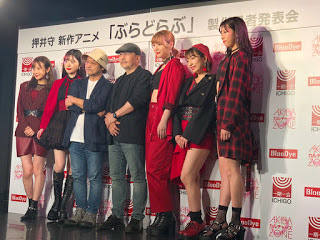
It was hard not to see the entire affair as a symbol of what’s wrong, and potentially right, with the current state of Japan’s anime industry. Like the rest of the country, its elders are aging fast. Skilled young talent is scant in Japan, and for employees under 40 or so, long hours and low wages have always been the norm. Studios are relying upon a thinning crop of seniors like Oshii, 67; Nishimura, 63; and Hayao Miyazaki, 78, all of whom are old enough to consider putting down their pens for good.
Read >>
 The Japan Times
The Japan TimesWriter and director Mamoru Oshii is best known for creating sci-fi thrillers that challenge orthodoxy with their philosophical musings and provocative, often nutty, imagery. His most famous film, the 1995 anime epic “Ghost in the Shell,” features a stone-cold cyborg heroine who dives nude off a skyscraper and is memorably dismembered by a tank.
But at a Tokyo press conference last week to introduce his latest project, a 12-episode slapstick comedy series titled “Vladlove,” all Oshii wanted to talk about was girls. Real ones. And a vampire named Mai.
“This time I wanted to take on a girl-meets-girl story,” he said. “The main characters are five schoolgirls. There won’t be any hot guys.”
Oshii is the series’ creator and chief director, working with fellow anime veteran Junji Nishimura (“Ranma ½”). Financed by Ichigo Animation, a newly formed subsidiary of a real estate and clean energy company, it premieres on TV and streaming platforms in spring 2020.
With a combined age of 130 years, the two men slouched atop stools on either side of a small stage in the basement of Akiba Cultures Zone, a six-story mall in Akihabara that sells anime-related merchandise. They presented a slide show of character sketches, during which Oshii jokingly admitted that he didn’t know anything about high school girls and had to ask younger people what they were like.
BlooDye, a female idol-pop group whose singers are all four decades younger than the directors, performed the show’s forgettable opening song before a series of photo shoots including Ichigo Animation’s Yutaka Nakanishi. No questions were taken, and many of the reporters grilled staffers in the lobby afterward for more information.

It was hard not to see the entire affair as a symbol of what’s wrong, and potentially right, with the current state of Japan’s anime industry. Like the rest of the country, its elders are aging fast. Skilled young talent is scant in Japan, and for employees under 40 or so, long hours and low wages have always been the norm. Studios are relying upon a thinning crop of seniors like Oshii, 67; Nishimura, 63; and Hayao Miyazaki, 78, all of whom are old enough to consider putting down their pens for good.
Read >>
Published on July 22, 2019 11:24
July 15, 2019
Why Hollywood doesn't get Anime
Published on July 15, 2019 03:38



